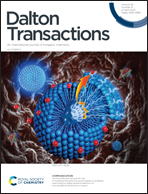The role of leached Zr in the photocatalytic reduction of CO2 to formate by derivatives of UiO-66 metal organic frameworks†
Abstract
This work reports the photocatalytic reduction of CO2 to formate that is mediated by UiO-66 Zr MOF derivatives. Amino-substituted UiO-66 is a known photocatalyst for this transformation, and herein we identify that this catalysis is due to leached Zr, not the MOF itself. No correlation between catalytic activity and crystal size is observed for UiO-66-NH2. Recycling studies along with SEM images of the crystals prior to and after catalysis support our conclusion that the catalytic performance can be described by the amount of leached Zr. Moreover, when the effect of the linker on the catalytic reaction is probed, all MOFs that facilitate the reduction of CO2 are found to leach Zr into solution. Correlation of the MOF (or linker) band gap energies to formate production indicates that this is an important parameter to the leached species. Combined with a linker exchange study, this indicates that the leached Zr still coordinates the linker. These results indicate that the UiO-66 Zr MOFs are not stable under typical photochemical conditions, and emphasize the importance of considering the role that leached metals play in catalysis.



 Please wait while we load your content...
Please wait while we load your content...